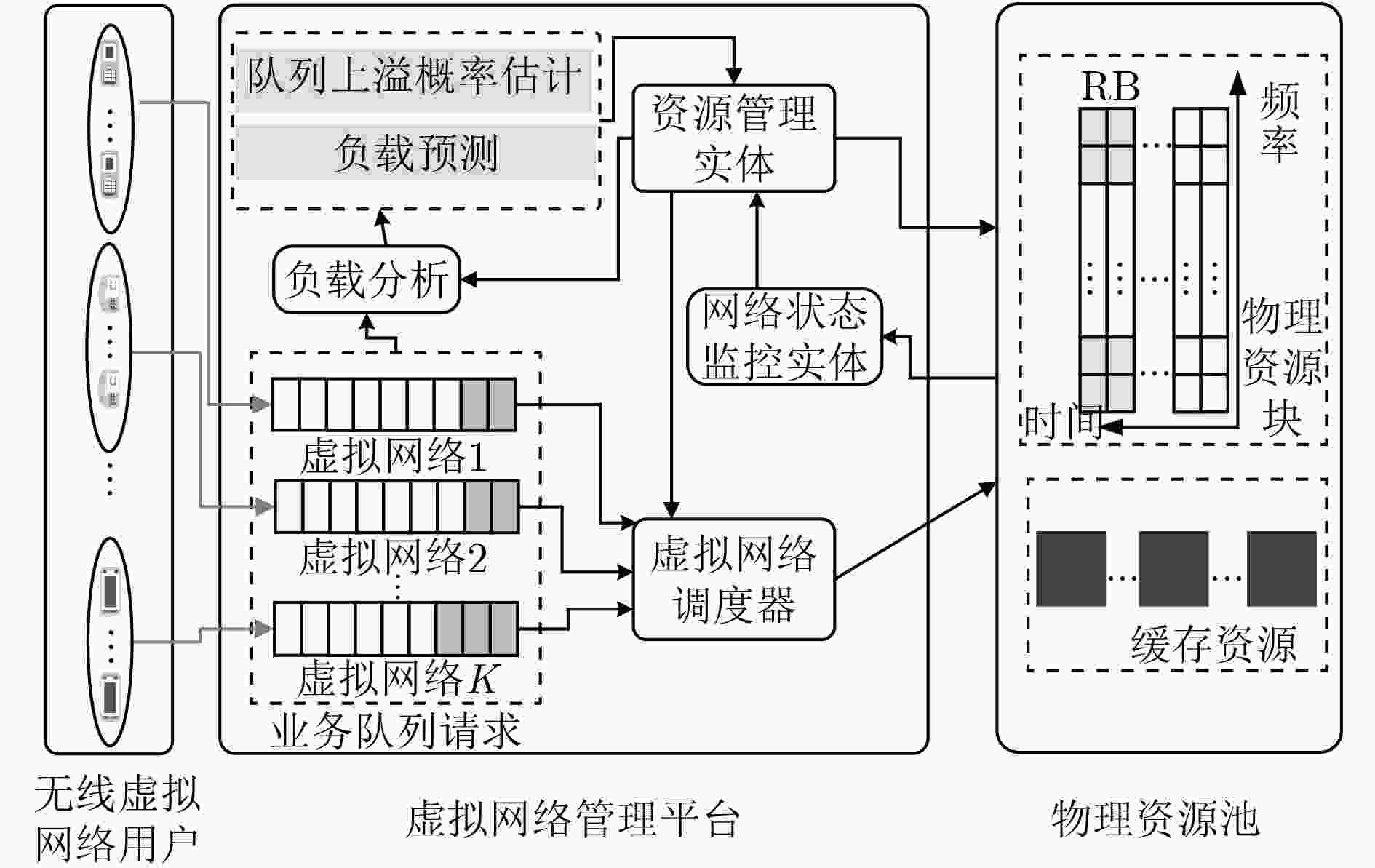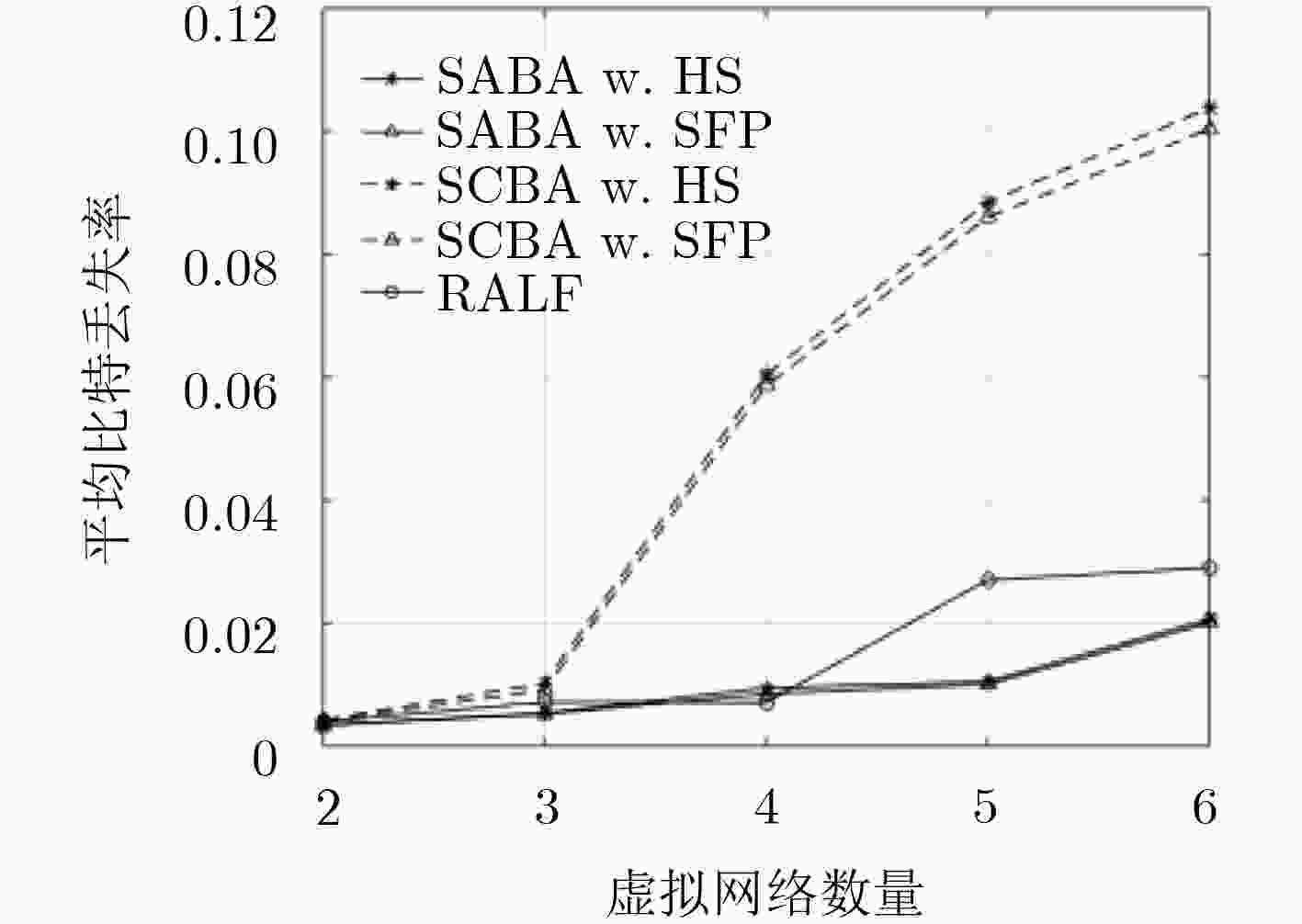ARMA-prediction Based Online Adaptive Dynamic Resource Allocation in Wireless Virtualized Networks
-
摘要:
该文针对无线虚拟化网络中业务的不确定和信息反馈的时延而引起虚拟资源分配不合理,提出一种基于自回归滑动平均(ARMA)预测的在线自适应虚拟资源分配算法。首先,该算法以保障虚拟网络队列上溢概率为目标对时频资源和缓存资源进行联合分配,并建立虚拟网络总成本最小化的理论分析模型。其次,考虑到虚拟网络对不同资源差异化的应用需求,设计了一种多时间尺度的资源动态调度机制,在长周期上基于ARMA模型的预测信息实现缓存资源的预留策略,在短周期上基于利用大偏差原理推导的队列上溢概率对虚拟网络优先级排序,并根据确定的优先级动态调度时频资源,从而满足各虚拟网络的业务需求。仿真结果表明,该算法可有效降低比特丢失率,同时提升物理资源的利用率。
Abstract:In order to solve the unreasonable virtual resource allocation caused by the uncertainty of service and delay of information feedback in wireless virtualized networks, an online adaptive virtual resource allocation algorithm proposed based on Auto Regressive Moving Average (ARMA) prediction. Firstly, a cost of virtual networks minimization is studied by jointly allocating the time-frequency resources and buffer space, while guaranteeing the overflow probability of each virtual network. Secondly, considering the different demand of virtual networks to different resources, a resource dynamic scheduling mechanism designed with multiple time scales, in which the reservation strategy of buffer space is realized based on the ARMA’s prediction information in slow time scale and the virtual networks are sorted according to the overflow probability derived by the large deviation principle and dynamically schedules the time-frequency resources in fast time scale, so as to meet the service demand. Simulation results show that the algorithm can effectively reduce the bit loss rate and improve the utilization of physical resources.
-
表 1 算法1:时频资源动态调度算法
(1) 在短周期$t$上观察当前各虚拟网络队列状态${Q_k} \left( t \right)$、预留的 缓存资源大小${B_k} $ (2) for $k = 1;k < K;k + + $ do (3) 计算${a_k} $,根据式(22)估计${{\widehat m}_k} $ (4) if ${{\widehat m}_k} \ge {a_k} $ then (5) 加入虚拟网络集合${{K}}_1 $,根据式(24)估计溢出剩余时间${T_k} $ (6) else (7) 加入虚拟网络集合${{K}}_2 $,执行黄金分割搜索算法估计 ${P_{\rm of}^k} \left( {t{\rm{ + }}T} \right)$ (8) end if (9) end for (10) while ${{K}}_1 \ne \varnothing $ do (11) 令$m = 1$,选择虚拟网络$k = {\arg \min }_{k \in {{K}}_1 } \left\{ {{T_k} } \right\}$ (12) while ${A_k} \left( t \right) > {C_k} \left( t \right)$ do
(13) $\begin{aligned} & m \leftarrow m + 1,{C_k} \left( t \right) \leftarrow mr, \\ &N \leftarrow N - 1 \\ \end{aligned} $(14) end while (15) ${{K}}_1 = {{K}}_1 \backslash \left\{ k \right\}$ (16) end while (17) while ${{K}}_2 \ne \varnothing$ do
(18) 令$m = 1$,选择虚拟网络${k^*} = {\arg \max }_{{k^*} \in {{K}_2}} \left\{ {P_{\rm of}^{{k^*}}\left( {t{\rm{ + }}T} \right) - {\varepsilon _{{k^*}}}} \right\}$(19) 重复步骤(12)—步骤(14) (20) ${{K}}_2 = {{K}}_2 \backslash \left\{ {k^ * } \right\}$ (21) end while (22) if $N \ne 0$ then (23) for $k = 1;k < K;k + + $ do (24) if ${C_k} \left( t \right) < \left({Q_k} \left( t \right) + {A_k} \left( t \right)\right)$ then (25) 加入虚拟网络集合${{K}}_3 $ (26) end if (27) end for (28) while ${{K}}_3 \ne \varnothing $ and $N \ne 0$
(29) 令$m = 1$,选择虚拟$k^{''} = {\arg \min }_{k^{''} \in {{K}}_3 } \left\{ {\alpha _{{k^{''}}}} \right\}$(30) $ {{while}} \quad \left({Q_{{k^{''}}}} \left( t \right) + {A_{{k^{''}}}} \left( t \right)\right) > \left({{\bar C}_{{k^{''}}}} \left( t \right) + {C_{{k^{''}}}} \left( t \right)\right)\quad {{do}} $ (31) $m \leftarrow m + 1,{{\bar C}_{{k^{''}}}} \left( t \right) \leftarrow mr,N \leftarrow N - 1$ (32) end while
(33) ${{K}}_3 = {{K}}_3 \backslash \left\{ {k^{''} } \right\}$(34) end while (35) end if 表 2 仿真参数设置
仿真参数 仿真值 虚拟网络数量 2,3,4,5,6 系统带宽 10 MHz (50 RBs) 短周期时长 1 ms 长周期时长 300 ms 负载到达过程 泊松分布 比特到达速率 $\lambda = 58.7\ {\rm kbit} $/ms RB单价$\alpha $ 1.2, 2.0, 1.5 unit/RB 缓存资源单价$\rho $ 8, 6, 4 unit/kbit 队列上溢概率$\varepsilon $ 0.13, 0.05, 0.12 滑动窗口大小${T_w} $ 60 ms 平滑指数$\eta $ 0.7 仿真时间 6600 ms -
AGIWAL M, ROY A, and SAXENA N. Next generation 5G wireless networks: A comprehensive survey[J]. IEEE Communications Surveys & Tutorials, 2017, 18(3): 1617–1655. doi: 10.1109/COMST.2016.2532458 KALIL M, AL-DWEIK A, SHARKH M A, et al. A framework for joint wireless network virtualization and cloud radio access networks for next generation wireless networks[J]. IEEE Access, 2017, 5: 20814–20827. doi: 10.1109/ACCESS.2017.2746666 ZHANG Haijun, LIU Na, CHU Xiaoli, et al. Network slicing based 5G and future mobile networks: Mobility, resource management, and challenges[J]. IEEE Communications Magazine, 2017, 55(8): 138–145. doi: 10.1109/MCOM.2017.1600940 RAHMAN M M, DESPINS C, and AFFERS S. Design optimization of wireless access virtualization based on cost & QoS trade-Off utility maximization[J]. IEEE Transactions on Wireless Communications, 2016, 15(9): 6146–6162. doi: 10.1109/TWC.2016.2580505 SALLENT O, PEREZ-ROMERO J, FERRUS R, et al. On radio access network slicing from a radio resource management perspective[J]. IEEE Wireless Communications, 2017, 24(5): 166–174. doi: 10.1109/MWC.2017.1600220WC JIANG Menglan, CONDOLUCI M, and MAHMOODI T. Network slicing management & prioritization in 5G mobile systems[C]. The 22th European Wireless Conference, Oulu, Finland, 2016: 1–6. ZHU Qixuan and ZHANG Xi. Game-theory based buffer-space and transmission-rate allocations for optimal energy-erfficiency over wireless virtual networks[C]. 2015 IEEE Global Communications Conference (GLOBECOM), San Diego, USA, 2015: 1–6. AHMADI H, MACALUSO I, GOMEZ I, et al. Substitutability of spectrum and cloud-based antennas in virtualized wireless networks[J]. IEEE Wireless Communications, 2017, 24(2): 114–120. doi: 10.1109/MWC.2016.1500303WC LEANH T, TRAN N, NGO D T, et al. Resource allocation for virtualized wireless networks with backhaul constraints[J]. IEEE Communications Letters, 2017, 21(1): 148–151. doi: 10.1109/LCOMM.2016.2617307 SCIANCALEPORE V, SAMDANIS K, COSTA-PEREZ X, et al. Mobile traffic forecasting for maximizing 5G network slicing resource utilization[C]. IEEE INFOCOM 2017-IEEE Conference on Computer Communications, Atlanta, USA, 2017: 1–9. CHU Yenming, HUANG Nenfang, and LIN Shenghsiung. Quality of service provision in cloud-based storage system for multimedia delivery[J]. IEEE Systems Journal, 2014, 8(1): 292–303. doi: 10.1109/JSYST.2013.2257338 AMIRI M and MOHAMMAD-KHANLI L. Survey on prediction models of applications for resources provisioning in cloud[J]. Journal of Network & Computer Applications, 2017, 82: 93–113. 李捷, 刘先省, 韩志杰. 基于ARMA的无线传感器网络流量预测模型的研究[J]. 电子与信息学报, 2007, 29(5): 1224–1227.LI Jie, LIU Xianxing, and HAN Zhijie. Research on the ARMA based traffic prediction algorithm for wireless sensor network[J]. Journal of Electronics &Information Technology, 2007, 29(5): 1224–1227. MANDJES M. Large Deviations for Gaussian Queues: Modelling Communication Networks[M]. Chichester: Wiley, 2007: 55–60. DEMBO A and ZEITOUNI O. Large Deviations Techniques and Applications[M]. Berlin: Springer, 2010: 303–304. YANG Jian, RAN Yongyi, CHEN Shuangwu, et al. Online source rate control for adaptive video streaming over HSPA and LTE-Style variable bit rate downlink channels[J]. IEEE Transactions on Vehicular Technology, 2016, 65(2): 643–657. doi: 10.1109/TVT.2015.2398515 GARDNER E Jr. Exponential smoothing: The state of the art—Part II[J]. International Journal of Forecasting, 2006, 22(4): 637–666. doi: 10.1016/j.ijforecast.2006.03.005 -






 下载:
下载:










 下载:
下载:
